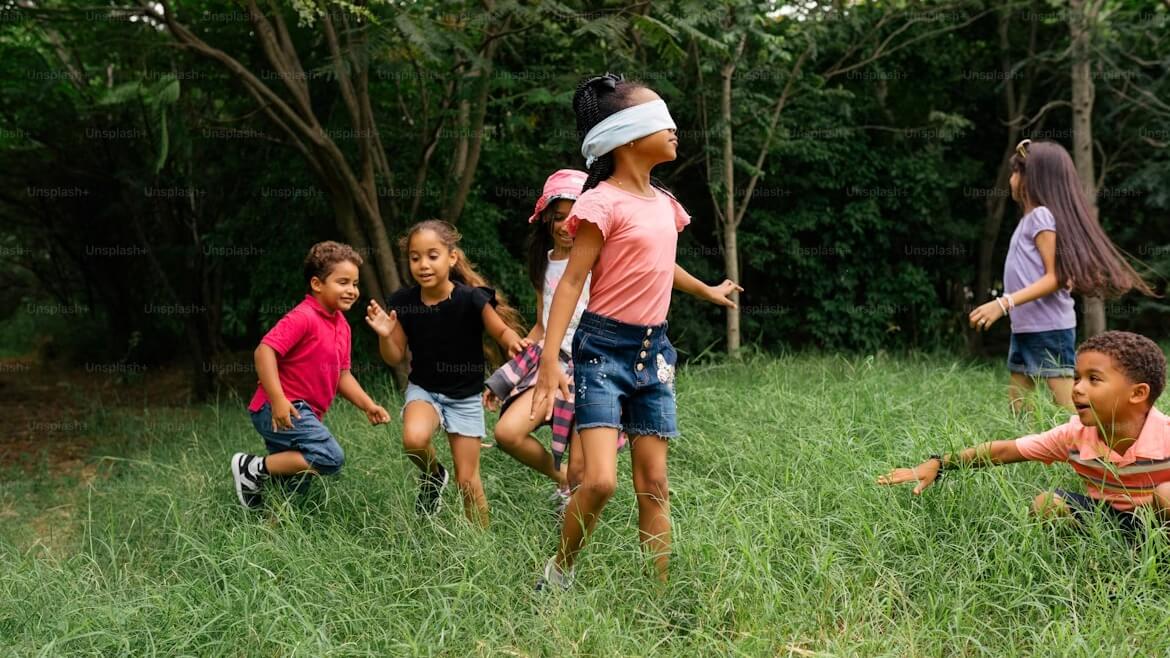30 Best Outdoor Games for Kids
Ron Spinabella Chief Editor / Oct 14, 2025
Outdoor activities, through the use of games, can better motivate children. Parents play a crucial role in organizing this process. More outdoor games are beneficial for developing children's gross motor skills and strengthening their physical resilience.

This article compiles 30 classic outdoor games that offer a wealth of creative ideas for outdoor activities. They encourage interaction between parents and children, and between children themselves, transforming these activities into more of a social interaction rather than a parallel relationship.
01. Hide and Seek
Hide and seek is a game nearly every child loves. It involves two characters: the Hider and the Seeker. Choose a suitable playing area and decide on your characters. At the start of the game, the Seeker, blindfolded or with their back to the others, counts to a specified number (such as 10 or 20), then begins searching the area until all the Hiders are found.

02. Sardines
Sardines, a derivative of Hide and Seek, the difference is that at the beginning of the game there is only one Hide and the others are Seekers. After they find the Hide, they will join in hiding. Gradually, the hiding place is filled with children like a can of sardines.
03. Tag
A tag can be understood as a physical contact, such as touching shoulders, arms, or backs. Tagging involves chasing and touching other children. They run, dodge, and even pull each other, engaging their entire bodies. Children's energy is fully unleashed through these outdoor activities.
In its simplest form, within a designated area, one child is designated as the chaser, while the others are the chased. The chaser must tag all the other children to complete the game (game objectives can be customized, such as tagging a certain number of children within a certain timeframe to win).
04. Chain Tag
The game can be viewed as a variation of Tag, often referred to as "chain chase." At the start, the chaser tags a player, and they then hold hands to form a chain. As more players are tagged, the chain grows longer. Eventually, all the children are connected in one chain. However, experience shows that as the chain lengthens, the difficulty of coordinating movements among the children increases significantly. This makes it harder for them to tag subsequent players, slowing down the overall pace of the game.
05. Freeze Tag
Frozen Tag game selects a "Frozen Man", and all the children tagged will be frozen (such as standing still with arms crossed), but other children who are still free can thaw the frozen children by tagging them. The goal of the Frozen Man is to freeze all the children.
06. Duck, Duck, Goose
In the game of Duck Duck Goose, the participating children form a circle facing inward. One child is designated as the "fox." This child walks around the circle, tagging each child while calling them "duck." However, one child will be called "Goose." When a child is named Goose, they must stand up and chase the fox around the circle. If the fox successfully returns to the vacant position left by the Goose without being tagged, the Goose becomes the fox in the next round.
07. Kit the Can
Kick the Can: A child is chosen as the chaser. A can (or yogurt carton) is placed in the center of the game area. When the game starts, the chasers hide in various places in the game area. The chaser counts and then gives chase. The tagged child will enter a standby state. If another chased person successfully kicks the can, all the children in the standby state will be reactivated. The goal of the game is to have all the chased people in the standby state.
08. Capture the Flag
In the flag-grabbing battle, the children are divided into two groups, and the game area is also divided into two halves. Each group has a small flag (which can be replaced by other items). The small flags are placed in their respective halves. The task of the game is to capture the other group's small flag and protect the flag of their group. After the game starts, the two teams must not only go deep into the opponent's area to capture the flag, but also protect their side. In the opponent's territory, they will be tagged by the opponent's team members and thrown into the opponent's confinement area. Only when their team members are tagged can they cancel the confinement status and re-enter the game (only one person can be helped to "escape" at a time). This is a fast-changing offense and defense game.
09. Spud
First, a server is chosen. The others form a circle. The server hits the ball high into the air and designates another player to catch it. If the player catches the ball, they shout "Spud," and the other players are frozen. The player who catches the ball throws it to anyone. If it's successful, the player who was hit becomes the server for the next round. If it's unsuccessful, the player who caught the ball becomes the server for the next round. A soft, bouncy ball is recommended.
10. Red Rover
The basic gameplay of the game involves dividing the children into two teams. Each team holds hands to form a line, standing opposite each other at a certain distance. When the game begins, one of the teams shouts, "Red Cover, Red Cover, Let them come over!" A member of the team that is called then steps out of the line to charge at the opposing team's formation. If they succeed in breaking the line, they can bring back one member of the opposing team to join their own. However, if they fail to break through, they will join the line of the team that was hit. The two teams take turns shouting, and the game continues until all the children have merged into one team.
11. Horse
The basic rules of the game involve children participating in a basketball shooting competition. The first player creates a move and claims they can score a goal. If they succeed, the next player imitates the first player's move and shoots. If the first player fails, they receive a letter from the word "HORSE." If they succeed, they enter the stage of creating their move, which the next player will imitate. The game repeats in a cycle. The player who collects all the letters of "HORSE" is eliminated.
12. Four Square
Divide the game area into four square areas (draw dividing lines with chalk or tape), and the four game partners are placed in the four areas. One player throws the ball into another area. The ball bounces and is caught by the game player in his area. Continue to throw it to any other three areas. If the ball is not caught or goes out of bounds or crosses the line during the throwing process, it is considered a failure.
13. Dodgeball
In Dodgeball, the basic rule is to divide the participating children into two teams, and the two teams are divided into two teams on both sides of the center line of the field. Multiple balls are placed on the center line. At the beginning of the game, players from both teams quickly run to the center line to grab the ball and start throwing it to the other team. If the other team catches it or throws it on their heads, the throw fails and they are out. If the ball touches the other team but is not caught, the other team is out. After dodging, the players from both teams who are not eliminated continue to pick up the balls that fall in their own area and throw them. Players from both teams cannot cross the center line, and the game ends with all players of one team being eliminated.

14. Red Light, Green Light
In the game, choose a child to act as the traffic light. They stand at one end of the play area with their backs to the traffic light. At the other end, the other children stand with as much space as possible between them. At the start of the game, the traffic light child will perform two actions:
When they turn around and yell "Red Light," all children must stop (remain frozen). Any child caught moving must return to the starting point and start over.
When they yell "Green Light," all other children must get as close to the traffic light as possible. The first child to tag the traffic light becomes the traffic light for the next round.
15. What's the time, Mr Wolf?
Many children are likely familiar with the game "Mr. Wolf, Mr. Wolf, What's the Time?" One child plays the role of Mr. Wolf, standing at one end of the play area with his back to the other children. The other children stand a distance away at the other end. At the start of the game, the children all shout in unison, "What's the time, Mr. Wolf?" Mr. Wolf has two responses:
1. o'clock, 2 o'clock, .... The children then move the corresponding number of steps toward Mr. Wolf (counting in unison).
2. If a child answers "Dinner Time" and turns to chase the other children, they must quickly retreat to the starting line. If Mr. Wolf tags them during this time, they become Mr. Wolf for the next round. However, if Mr. Wolf is tagged before he shouts "Dinner Time," he loses and must continue playing Mr. Wolf in the next round.
16. Button,Button,Who's Got the Button
The participating children sit in a circle. Each child holds out their hands with their palms together. One child in the middle holds the button and will pass it to one of the children. To cover up the situation, they pretend to put the button into the hands of all the children. One of the children actually gets the button. Then everyone has to guess which child actually got the button. Before guessing, everyone shouts "Button, Button, Who's Got the Button" in unison. The child who guessed correctly gets the chance to pass the button to the children in the next round.
17. Simon Says
The rules of the Simon Says game are to select a child to be Simon and give instructions to the other children. If the instruction is preceded by the modifier "Simon says", all children need to follow the instruction. If not, there is no need to respond.
| Commands of Simon Says |
|---|
| Simon says, touch your nose. |
| Simon says, jump three times. |
| Simon says, clap your hands. |
| Simon says, spin around. |
| Simon says, stand on one foot. |
| Simon says, wave your right hand. |
| Simon says, sit down. |
| Simon says, blink your eyes. |
| Simon says, stomp your feet. |
| Simon says, put your hands on your head. |
18. Freeze Dance
Take a portable Bluetooth speaker outdoors and play some cheerful music. When the music starts, everyone is required to jump around. When the music stops suddenly, all participants are instantly "frozen" and must maintain their dancing posture. Those who cannot persist must quit. This requires controlling body balance and concentration to complete.
19. Tic-Tac-Toe
Tic-Tac-toe, this game can be found in many amusement park facilities. The goal of the game is that the two players who form a line (OOO (or XXX)) in any direction horizontally, vertically or diagonally with their O (or X) will win.
20. Hopscotch
Hopscotch is an ancient and classic game played around the world. The rules are well-known to many, but here's a brief overview. A typical hopscotch game has nine numbered tiles, with 9 being the rotating tile. When the game begins, children throw a stone (or sandbag) onto the first tile. Then, they jump over the first tile and start hopping on one foot from the second tile. They step on each of the numbered tiles, continuing to hop to the ninth tile, turning around and then hopping to the second tile. This completes a round, where they pick up the stone from the first tile and hop back to the starting point. They then throw the stone to the second tile, continuing the second, third, and so on. The game ends if the stone falls outside the line, the player is unable to support themselves with one foot, or the player hits the line.

21. Obstacle Course
Create a series of obstacles for your child using anything you have around the house. Have your child crawl over an oversized pillow, then through a cardboard box, then around a footstool, and finally sprint towards the door.
22. Stretching
Stretching is a great exercise. Teach your child to stretch every morning, or in the yard after reading or watching cartoons. For example, stretch your arms toward the sky, trying to touch your toes, or bend over. Keep the movements simple and demonstrate them to your child.
23. Scavenger Hunt
Find a few toys, balls, or other items to hide in the yard. Create a treasure hunt list and help your child identify the specific items. Be careful when hiding favorite items and ask your child's permission. Some children may enjoy the feeling of finding a cherished possession. Others may find the thought of parting with a cherished item unbearable. Be sure to ask your child's permission beforehand.
24. Kickball
The rules of Kickball are the same as those of baseball, with first base, second base, and third base. The difference is that instead of hitting the ball with a baseball, you kick it with your feet.
25. Scoop Ball
Scoop Ball is a ball game played in pairs. The game involves throwing a ball to each other and catching it with a paddle or scoop. For team play, divide the children into four teams, and have one child from each team catch the ball with a paddle or scoop and then run back and forth without dropping it.
26. Tetherball
A ball hangs from a pole. Two children compete. When one child hits the ball, it spins around the pole many times. The other child tries to hit the ball in the other direction, making it spin. If one line of rope runs out of loops, the child who successfully spins the ball wins the game.
27. Frisbee
Frisbee can be played in a variety of ways. It's a great two-person game, perfect for developing running and catching skills. It requires ample space. Besides being a two-person game, you can also bring a group of children together to play Frisbee baseball. The rules are the same as baseball, but the object is a Frisbee instead of a ball.
28. Jump Ropes
Jump Rope is also very popular. Children can practice four different skipping styles: skipping with the rope forward, skipping with the rope backward, skipping with the rope crossed, and skipping with two people.
29. Potato Sacks
Divide the children into four groups, and have one child from each group jump back and forth in the bag. Be aware that some children may have difficulty maintaining balance and may fall, so it's recommended that you play this game on a lawn.
30. Twister
Twister is a classic American party game. The ultimate goal is to twist everyone into a ball. The game involves a plastic rug printed with various colors and a color wheel. Players take turns spinning the wheel, which indicates which hand or foot they need to press on which color of the rug.
Final Thoughts
Outdoor activities have always been a good way to get close to nature and breathe fresh air. Parents choose the outdoor games we mentioned to cultivate their children's observation and learning abilities, allowing their children to get closer to nature and breathe fresh air!
Disclaimer
Any assessments and their associated content on this website, regardless of date, are not intended to replace direct medical advice from your physician or other professional. If you experience severe or persistent symptoms, please consult a licensed mental health professional or healthcare provider.







